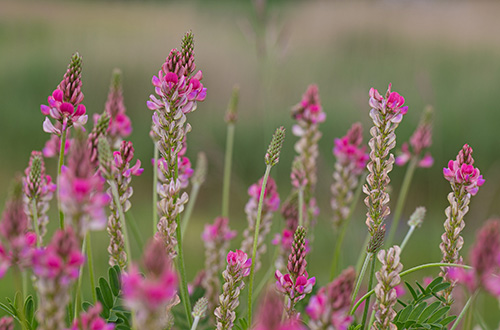- Soil Association
- Farmers & growers
- Low-input farming advice
- Herbal leys
- Herbal Leys 'How To' Guide

Herbal Leys 'How To' Guide
The basics and benefits of herbal leys
Herbal leys (or diverse swards) are sown pastures made up of a mix of grasses, herbs and legumes. Together they deliver soil fertility, biology and structure, boost livestock health, encourage biodiversity and are productive with low rainfall.

Sheep on herbal leys, Oak Farm, Devon (Bex Tyers)

Sainfoin
Diversity is key
Each species has different functions, which makes the mixture work better overall. They improve the soil in different ways, producing greater yields, and also have different nutritional functions.
Choosing the right mix of seeds is key, and depends on your soil type, geography and desired outcomes. A mixture can include anything from 3 to 30 species, though a minimum of 6 is usually about right to get a good range of functions.

Cows in diverse sward (Rob Thornhill)

Yarrow
Planning is crucial, so think about:
- How establishing the ley fits within your arable rotation or other temporary grass reseeds.
- Achieving the best seed bed preparation possible (cultivate/harrow to fine tilth, roll, ideally
- broadcast sow, then roll and roll again! If drilling, ensure max 1cm depth. Over-sowing
- can be successful but destroy as much competition as possible).
- Timing of sowing – see 'Likely timescales', below.
- When to start grazing (i.e. if autumn sowing, light graze before winter).
- When to rest leys. You need to account for fencing, water provision and shelter.
- Sowing a diversity of plants with differing growth rates (which leads to a longer
- growing season overall).
- Allowing areas of the sward to flower and set seed to replenish the seedbank
- and provide food for wildlife.
Likely timescales
Four years is considered an optimal length for herbal leys in the rotation, to allow for root growth, soil fertility building and high species diversity. Longer periods will be even better for the soil, but you are likely to see a decline in species diversity unless it is very carefully managed.
Timing of sowing
Warm soil is needed for germination (8-10°c), along with good levels of soil moisture – so sow in August/early Sept or later in April/May once soil has warmed. Be careful not to over graze too early (6-8 weeks post establishment).
Spring sow – April-May
Light graze – June-July
Autumn sow – August-September
Light Graze – October-November
When choosing species, think about:
- Your soil, climate and the management you intend to carry out (e.g. grazing, cutting).
- What functions you want from your ley (drought resilience, soil improvement, maximum forage production, biodiversity provision).
- How the balance of plants in the sward will change over time – be prepared for some trial and error.
Properties of key ley species
Grasses – energy rich, Legumes – protein rich, Herbs – provide micronutrients
Legumes
Clovers, Birdsfoot trefoil, Lucerne, Sainfoin, Vetches
Function: Build fertility by adding nitrogen.
Benefit: Cost effective and climate friendly alternative to adding nitrogen fertiliser.

Birdsfoot trefoil
Deep rooters
Chicory, Lucerne, Sainfoin, Cocksfoot, Sheep’s parsley, Burnet, Yarrow, Plantain
Function: Access moisture from deep down while sinking carbon into soil; Tap roots break up compaction and rooting mat provide a ‘sponge’ in wet soils.
Benefit: Carbon is less likely to be released; improves infiltration and drainage; increased resilience to low rainfall.

Chicory
Anthelmintics
Chicory, Sainfoin, Birdsfoot trefoil
Function: Contain high levels of condensed tannins.
Benefit: Reduces worm burden.

Sainfoin
Mineral-rich
Plantain, Chicory, Sheep’s parsley, Yarrow, Burnet
Function: Mine minerals from the soil making them available to livestock.
Benefit: Provides naturally rich source of minerals, reducing need to buy them in.

Plantain
Flowering plants
Burnet, Chicory, Birdsfoot trefoil, Lucerne
Function: Food for pollinators.
Benefit: Attract beneficial predators and increase biodiversity.

Lucerne
The financials
Pros
- Saving on fertiliser (nitrogen fixing plants can fix up to 250 kg N/ha).
- Saving costs of mineral feed plus supplementary feeding in drought.
- Increased yields – different plants, when grown together, can yield 50% more than an average rye grass sward.
Cons
- Increased seed cost.
- ‘Trial and error’ period of establishment.
Next steps
Download as PDF

Good sources of further advice and information
Cotswold Seeds: cotswoldseeds.com
Talk to an expert: 01608 652552
AHDB: ahdb.org.uk/knowledge-library/herbal-leys
Grassland Society: britishgrassland.com
Do you know about Soil Association Exchange?
Developed to enable farmers to reap the rewards of sustainable farming that works with nature. Register today for updates and to have first access to a service that works with farmers to help evolve the way we farm for the better.
soilassociationexchange.com
Download Herbal Leys How To Guide
With information on the basics and benefits, species selection, planning, timescales, the financials and where to go for more information
Download PDF